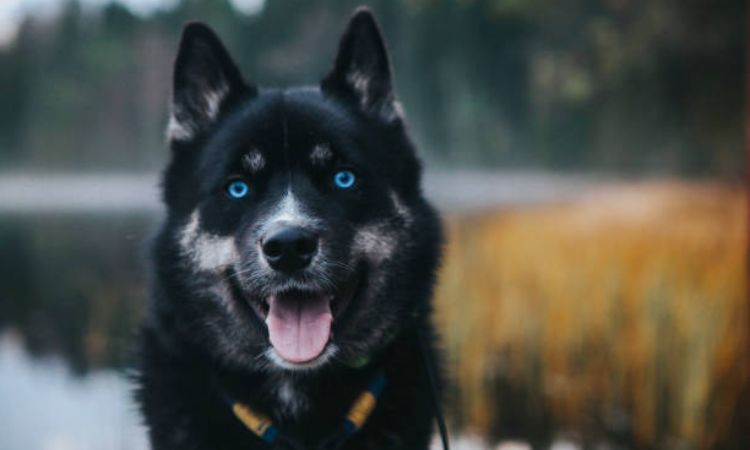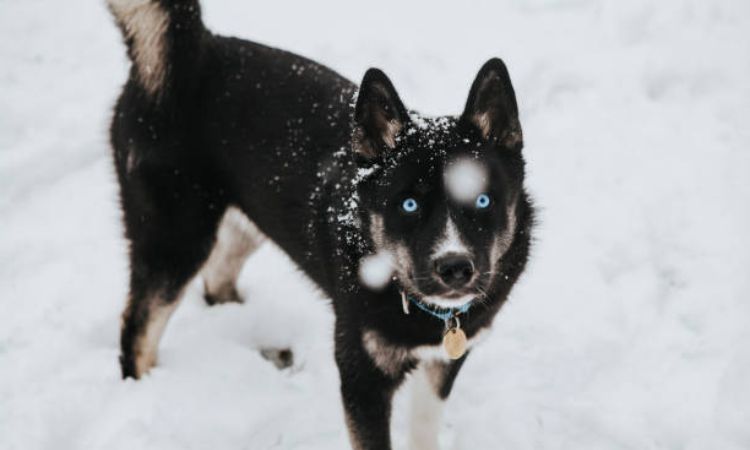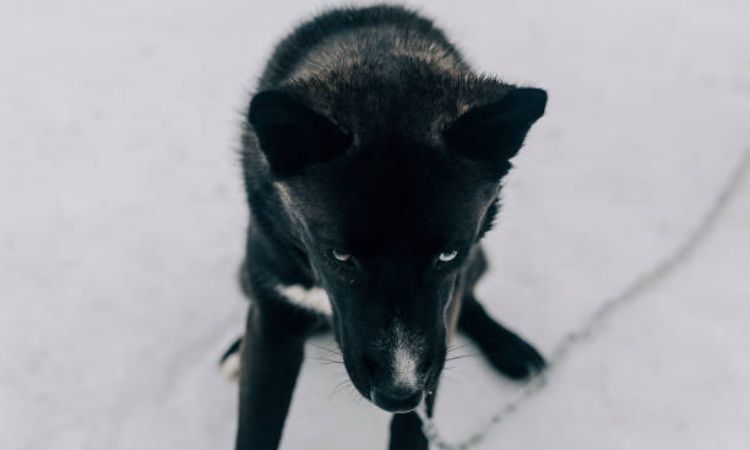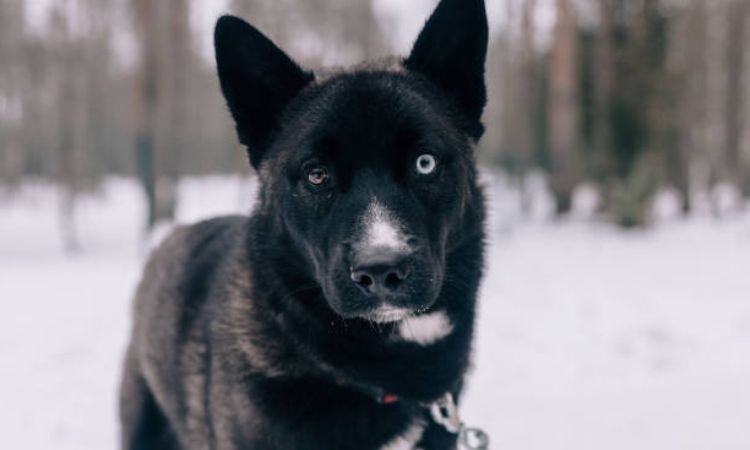With their striking midnight coats and eyes that gleam like shards of ice, Black Huskies are nothing short of mesmerizing. Equal parts charm and energy, these dogs captivate hearts wherever they go.
Whether you’re curious about their unique look, wondering what they cost, or searching for tips on proper care, this guide from Nexus-Pets will walk you through everything you need to know about the Black Husky.

What Is a Black Husky?
A Black Husky is not a separate breed but rather a color variation of the Siberian Husky, a working dog originally bred by the Chukchi people of Siberia. While Siberian Huskies are famous for their wolf-like appearance, stamina, and friendly personalities, the black-coated variety stands out for its striking, dramatic look. These dogs carry the same lineage, history, and temperament as other Siberian Huskies, but their dark coats make them particularly eye-catching.
Difference Between Pure Black, Black-and-White, and Solid Coat Varieties
- Pure Black Husky: A relatively rare variation in which more than 90% of the coat is black, often with little to no white markings. This solid shade gives the dog a sleek, powerful presence.
- Black-and-White Husky: The most common variation, where black fur dominates but is balanced with white markings on the face, chest, legs, and tail tip. These striking contrasts highlight the Husky’s sharp features and blue or bi-colored eyes.
- Solid-Coat Varieties: While many Huskies display a mix of colors, true solid coats—whether fully black or fully white—are less common. Solid black Huskies in particular are prized by enthusiasts for their rarity and beauty.
Genetics Behind Black Fur in Huskies
The black coat in Huskies is the result of specific genetic factors that influence pigment distribution. The primary gene involved is the Agouti gene (A locus), which determines whether a Husky’s fur shows banded patterns (such as agouti or sable) or solid colors. When the dominant black allele is expressed and other color-influencing genes are suppressed, the result can be a mostly or entirely black coat. However, due to the breed’s wide genetic diversity, black Huskies still often carry recessive traits that can produce white markings or lighter shades in future litters.

Black Husky Appearance
Coat Color Types: Solid Black, Black-and-White, Dilute Black
Black Huskies display a variety of coat patterns, all influenced by genetics:
- Solid Black: Rare among Siberian Huskies, this variation features an almost entirely black coat (90% or more), with little to no white markings. These dogs have a sleek, bold appearance that sets them apart.
- Black-and-White: The most common variety, combining deep black fur with distinctive white markings on the chest, legs, tail tip, and face. The balance of dark and light fur emphasizes the Husky’s signature wolf-like look.
- Dilute Black (Seal or “washed black”): Appears lighter due to genetic influences that reduce eumelanin pigment. These Huskies may look grayish-black or sooty, with areas of cream or yellow tones blending into the coat.
Eye Colors (Blue, Amber, Brown, Heterochromia)
One of the most captivating features of Black Huskies is their eyes. Typical colors include:
- Icy Blue: The most iconic Husky eye color, offering a piercing, intense look.
- Amber or Brown: Warmer tones that create a softer expression and sometimes give the dog a more wolfish appearance.
- Heterochromia: A genetic trait where each eye is a different color (e.g., one blue, one brown) or where a single eye is split into two shades. This rare feature adds to the Husky’s mystique and uniqueness.
Size, Weight, and Body Structure
Black Huskies share the same physical build as standard Siberian Huskies:
- Height: 20–23.5 inches (51–60 cm) at the shoulder.
- Weight: 35–60 pounds (16–27 kg), with females typically smaller than males.
- Body Type: Medium-sized, athletic, and well-proportioned with erect triangular ears, a fox-like face, and a bushy, sickle-shaped tail. Their double coat—dense undercoat and longer guard hairs—protects them in cold climates.
Distinguishing Features Compared to Standard Siberian Huskies
While Black Huskies have the same body structure and temperament as any Siberian Husky, a few traits make them stand out:
- Their predominantly black coats set them apart from the more common gray-and-white or red-and-white Huskies.
- Solid black coats and certain dilute variations are rare, making them especially sought after by enthusiasts.
- The contrast between their dark fur and striking eyes (especially ice-blue or heterochromatic) gives them a dramatic, unforgettable appearance.

Black husky dog photos
Black Husky Price
The cost of a Black Siberian Husky can vary widely depending on several factors, including the breeder, coat type, eye color, age, and pedigree. On average, you can expect to pay between $600 and $1,500 for a purebred puppy from a reputable breeder. Huskies with rare coat colors, such as solid black, or striking eye combinations like heterochromia, may fall on the higher end of this range.
If you’re adopting from a shelter or rescue, prices are significantly lower, typically ranging from $150 to $400, though these dogs may not come with full registration papers or detailed lineage. Breeders who specialize in Black Huskies often emphasize strong bloodlines, temperament, and health guarantees, which can justify the higher price.
Additional costs to consider beyond the initial purchase include veterinary care, vaccinations, food, grooming tools, and optional pet insurance. Siberian Huskies are generally healthy dogs, but preventive care and routine check-ups are essential to maintain their well-being. Annual ownership costs, including food, medical care, and supplies, can range from $1,300 to $5,000 depending on your Husky’s specific needs.
Black Husky Care Guide

1. Diet & Nutrition
- High-quality dog food: Choose food appropriate for your Husky’s age, size, and activity level.
- Portion control: Avoid overfeeding to prevent obesity, a common issue in active breeds.
- Fresh water: Ensure clean water is always available, especially after exercise.
- Supplements: Consider joint or skin supplements if recommended by a vet.
2. Exercise & Mental Stimulation
- Daily activity: Huskies are highly energetic; they need at least 1–2 hours of exercise per day.
- Outdoor play: Safe fenced yards, long walks, or leash runs help expend energy.
- Interactive play: Engage with toys, fetch, or puzzle feeders to prevent boredom.
- Dog sports: Activities like skijoring, bikejoring, or agility training suit their working-dog instincts.
3. Grooming
- Coat care: Black Huskies have thick double coats that require weekly brushing. During shedding seasons (spring and fall), daily grooming is recommended.
- Bathing: Bathe only when necessary to avoid stripping natural oils.
- Nail trimming: Keep nails short to prevent discomfort and injury.
- Dental hygiene: Brush teeth 2–3 times a week to prevent tartar buildup.
- Ear care: Clean ears weekly to avoid infections.
4. Training & Socialization
- Early socialization: Introduce your Husky to different people, pets, and environments from a young age.
- Consistent training: Positive reinforcement works best; Huskies can be independent and stubborn.
- Leash training: Critical due to high prey drive and tendency to wander.
5. Health Monitoring
- Regular vet visits: Annual check-ups and vaccinations are essential.
- Common health concerns: Watch for hip dysplasia, eye issues (cataracts, glaucoma), thyroid problems, and skin conditions.
- Weight management: Keep your Husky at a healthy weight to avoid joint and metabolic issues.
- Parasite prevention: Regular treatments for fleas, ticks, and worms are important.
6. Environment & Safety
- Secure fencing: Huskies are escape artists; ensure yard is fully enclosed.
- Climate considerations: Provide shade and water in hot weather; Huskies tolerate cold better than heat.
- Mental stimulation: Prevent boredom and separation anxiety by providing toys, companionship, and structured activity.
7. Signs to Watch For
- Lethargy, loss of appetite, or unusual aggression
- Limping, difficulty standing, or stiffness
- Eye or skin changes, unusual lumps, or hair loss
- Breathing difficulties or excessive panting
Summary: Black Huskies are intelligent, active, and social dogs. Proper diet, exercise, grooming, training, and health care are key to keeping them happy and healthy. With the right care, a Black Husky can be a loyal and playful companion for years.
You may be interested in: All Black Alaskan Malamute: The Powerful Coat
A guide like this can only scratch the surface of what it’s like to have a black Husky. They’re a rare and stunning breed that deserves a loving home and consistent care. If you’re ready to embrace the unique challenges and rewards that come with owning one, you’ll be well on your way to a one-of-a-kind companionship.






